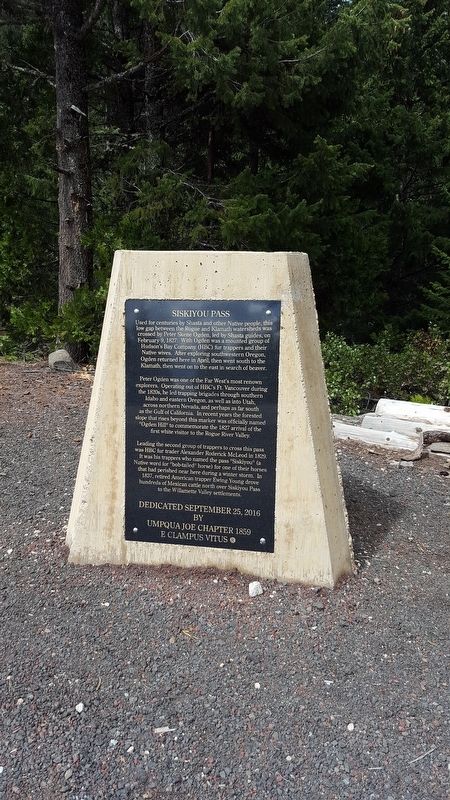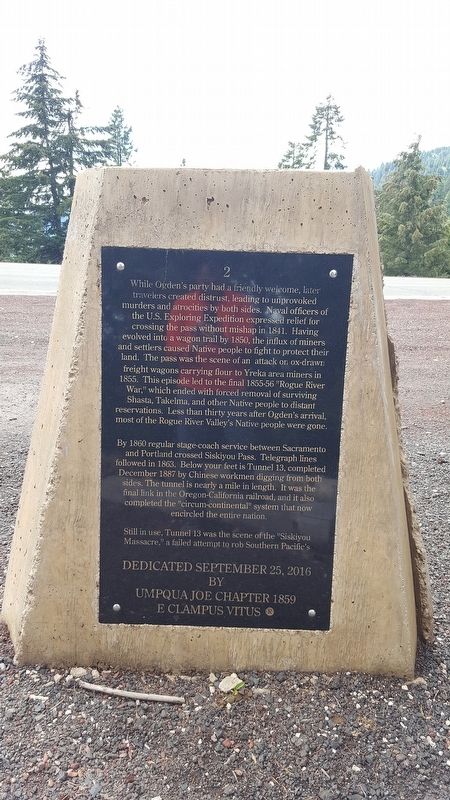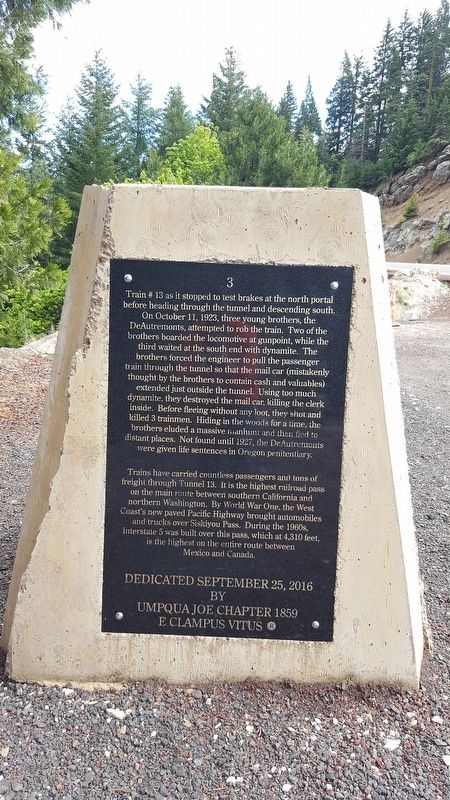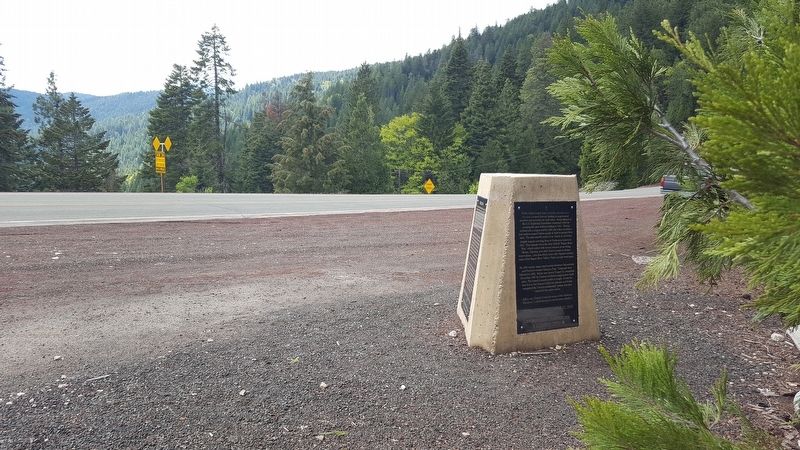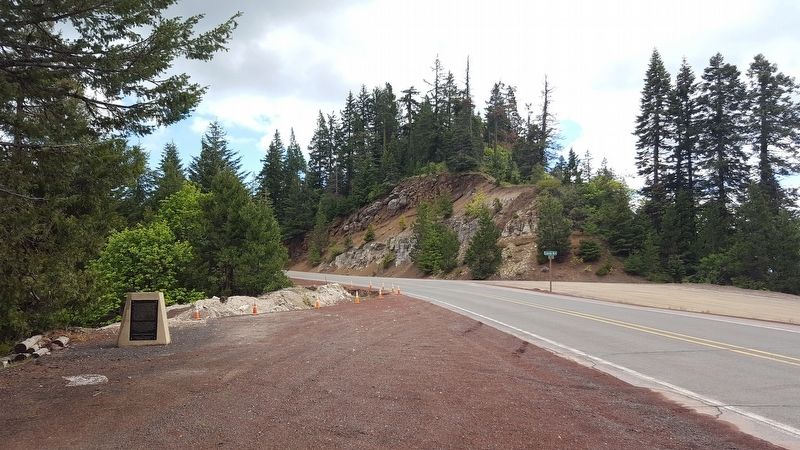Ashland in Jackson County, Oregon — The American West (Northwest)
Siskiyou Pass
Used for centuries by Shasta and other Native people, this low gap between the Rogue and Klamath watershed was crossed by Peter Skene Ogden, led by Shasta Guides, on February 9, 1827. With Ogden was a mounted group of Hudson’s Bay Company (HBC) fur trappers and their Native wives. After exploring southwestern Oregon, Ogden returned here in April, then went south to the Klamath, then went on to the east in search of beaver.
Peter Ogden was one of the Far West’s most renown explorers. Operating out of HBC’s Ft. Vancouver during the 1820s, he led trapping brigades through southern Idaho and eastern Oregon, as well as into Utah, across northern Nevada, and perhaps as far south as the Gulf of California. In recent years the forested slope that rises beyond this marker was officially named "Ogden Hill" to commemorate the 1827 arrival of the first white visitor to the Rogue River Valley.
Leading the second group of trappers to cross this pass was HBC fur trader Alexander Roderick McLoud in 1829. It was his fur trappers who named the pass "Siskiyou" (a Native word for "bob-tailed" horse) for one of their horses that had perished near here during a winter storm. In 1837, retired American trapper Ewing Young drove hundreds of Mexican cattle north over the Siskiyou Pass to the Willamette Valley settlements.
Side 2
While Ogden’s party had a friendly welcome, later travelers created distrust, leading to unprovoked murders and atrocities by both sides. Naval officers of the U.S. Exploring Expedition expressed relief for crossing the pass without mishap in 1841. Having evolved into a wagon trail by 1850, the influx of miners and settlers caused Native people to fight to protect their land. The pass was the scene of an attack on ox-drawn freight wagons carrying flour to Yreka area miners in 1855. This episode led to the final 1855-56 "Rogue River War," which ended with forced removal of surviving Shasta, Takelma, and other Native people to distant reservations. Less than thirty years after Ogden’s arrival, most of the Rogue River Valley’s Native people were gone.
By 1860 regular stage-coach service between Sacramento and Portland crossed Siskiyou Pass. Telegraph lines followed in 1863. Below your feet is Tunnel 13, completed December 1887 by Chinese workmen digging from both sides. The tunnel is nearly a mile in length. It was the final link in the Oregon-California railroad, and it also completed the "circum-continental" system that now encircled the entire nation.
Still in use, Tunnel 13 was the scene of the "Siskiyou Massacre," a failed attempt to rob Southern Pacific’s
Side 3
Train # 13 as it stopped to test brakes at the north portal before heading through the tunnel and descending south. On October 11, 1923, three young brothers, the DeAutremonts, attempted to rob the train. Two of the brothers boarded the locomotive at gunpoint, while the third waited at the south end with dynamite. The brothers forced the engineer to pull the passenger train through the tunnel so that the mail car (mistakenly thought by the brothers to contain cash and valuables) extended just outside the tunnel. Using too much dynamite, they destroyed the mail car, killing the clerk inside. Before fleeing without any loot, they shot and killed 3 trainmen. Hiding in the woods for a time, the brothers eluded a massive manhunt and then fled to distant places. Not found until 1927, the DeAutremonts were given life sentences in Oregon penitentiary.
Trains have carried countless passengers and tons of freight through Tunnel 13. It is the highest railroad pass on the main route between southern California and northern Washington. By World War One, the West Coast’s new paved Pacific Highway brought automobiles and trucks over Siskiyou Pass. During the 1960s, Interstate 5 was built over this pass, which at 4,310 feet, is the highest on the entire route between Mexico and Canada.
Erected 2016 by E Clampus Vitus Umpqua Joe Chapter 1859.
Topics and series. This historical marker is listed in these topic lists: Exploration • Native Americans • Railroads & Streetcars • Wars, US Indian. In addition, it is included in the E Clampus Vitus series list. A significant historical date for this entry is February 9, 1827.
Location. 42° 4.36′ N, 122° 36.955′ W. Marker is in Ashland, Oregon, in Jackson County. Marker is on Mt Ashland Ski Rd, on the right when traveling north. Touch for map. Marker is in this post office area: Ashland OR 97520, United States of America. Touch for directions.
Other nearby markers. At least 8 other markers are within 6 miles of this marker, measured as the crow flies. Siskiyou Mountain Wagon Road (about 300 feet away, measured in a direct line); a different marker also named Siskiyou Mountain Wagon Road (approx. 1.4 miles away); a different marker also named Siskiyou Mountain Wagon Road (approx. 3.1 miles away); Barrow Station (approx. 3.7 miles away); Route of (approx. 4.6 miles away); Route of Historic Applegate Trail (approx. 4.9 miles away); Hilt War Memorial (approx. 5.3 miles away in California); Hilt, CA (approx. 5.3 miles away in California). Touch for a list and map of all markers in Ashland.
More about this marker. Marker contains three
plaques on three sides.
Credits. This page was last revised on May 28, 2019. It was originally submitted on May 28, 2019, by Douglass Halvorsen of Klamath Falls, Oregon. This page has been viewed 468 times since then and 30 times this year. Photos: 1, 2, 3, 4, 5. submitted on May 28, 2019, by Douglass Halvorsen of Klamath Falls, Oregon. • Andrew Ruppenstein was the editor who published this page.
